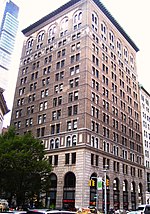23rd Street station (IRT Lexington Avenue Line)

The 23rd Street station is a local station on the IRT Lexington Avenue Line of the New York City Subway. Located at the intersection of Park Avenue South and 23rd Street in Gramercy Park and Flatiron District, Manhattan, it is served by 6 trains at all times, <6> trains during weekdays in the peak direction, and 4 trains during late night hours. The 23rd Street station was constructed for the Interborough Rapid Transit Company (IRT) as part of the city's first subway line, which was approved in 1900. Construction of the line segment that includes the 23rd Street station started on September 12 of the same year. The station opened on October 27, 1904, as one of the original 28 stations of the New York City Subway. The station's platforms were lengthened in the late 1940s. The 23rd Street station contains two side platforms and four tracks; express trains use the inner two tracks to bypass the station. The station was built with tile and mosaic decorations, which are continued along the platform extensions. The platforms contain exits to 22nd Street to the south and 23rd Street to the north. The platforms are not connected to each other within fare control. The station contains elevators from the street, which make it compliant with the Americans with Disabilities Act of 1990.
Excerpt from the Wikipedia article 23rd Street station (IRT Lexington Avenue Line) (License: CC BY-SA 3.0, Authors, Images).23rd Street station (IRT Lexington Avenue Line)
Park Avenue South, New York Manhattan
Geographical coordinates (GPS) Address Nearby Places Show on map
Geographical coordinates (GPS)
| Latitude | Longitude |
|---|---|
| N 40.740169 ° | E -73.98644 ° |
Address
Park Avenue South
10016 New York, Manhattan
New York, United States
Open on Google Maps









